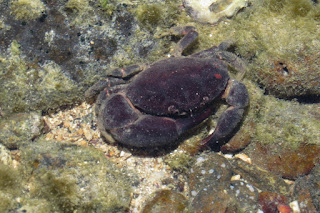Clairview and St
Lawrence are important habitats for larger creatures such as koalas,
greater gliders, possums, goannas, emus and a wide variety of
wallabies but these creatures are not easy to find. The area is on
the threshold for many wildlife species and they occur only in the
better pockets of land or at low densities. It is easier to find
smaller creatures that can live in smaller patches habitat. Wetlands
and watercourses are where the action is.
 |
| Roadside tree with koala and possum scratches (click to zoom in) |
 |
| A brushtail possum in BarraCrab Caravan Park |
At Clairview, at the
southern end of the beach past the caravan park is a tidal creek with
large colonies of fiddler crabs on the adjacent flats about 100 m out
from the beach. There are two main species, a large species with hot pink
nippers and green backs and a small species with a grey-white nipper.
The smaller species makes up for lack of colour by waving so
frantically that the crabs sometimes bounce across the ground. It is
a great place for kids to discover a few wild creatures and perhaps
even catch some.
 |
| Fiddler crab colonies are on side opposite this large mangrove |
 |
| Uca seismella - little white bouncing fiddler crabs are on the lower bank |
 |
| Two-tone fiddler crabs (U. vomeris) and smaller pink fiddler crabs |
 |
| Pink fiddler crab - Uca polita |
 |
| Near the mangroves are red climber crabs (Metapograpsus frontalis) |
Male fiddler crabs
have one large nipper for demonstrating their power and a tiny nipper
for feeding. Very rarely a crab will have two large nippers.
Finding one of these is the Queensland equivalent of finding a four
leaf clover and I found one at Clairview. In forty years, I have only seen four such crabs.
The fiddler crabs
that dominates the banks of St Lawrence Creek are a different
species, one which prefers salt pans to the intertidal mud flats.
 |
| Uca signata (click to enlarge) |
If you are lucky to
be present when the tide is rising and filling the creek out from the
beach, you may see popeye mullet. These strange fish swim with the
eyes above water so that they can see predatory birds. The lower
part of their eye has differently shaped optics so that they can see
underwater. If the tide is out, the bottom of the creek is filled
with fine soft silt that perfectly records the prints of a multitude
of mostly unseen creatures including sea turtles, gropers, giant mud
skippers, mud crabs and much more. Working out which creatures made
which prints can be a challenge.
 |
| Pop-eye mullet in St Lawrence Creek |
Unfortunately, the
popeye mullet are not reliably present and chances of seeing these
strange fish are better in St Lawrence Creek, which flows past the
town of St Lawrence and is about 20 km from Clairview. Clairview is
an old volcanic area and has low hills of volcanic origin, whereas St
Lawrence is located in an ancient coal basin, filled with deep
sediments. Despite their spatial proximity Clairview and St Lawrence
are in different bioregions, which are the ecological equivalent of
countries. The climate, landforms and geology differ enough that
different groups of species dominate. At Clairview the eucalypts
have green foliage and close to St Lawrence the foliage is usually
grey. The boundary is diffuse being about 10 km wide and there is no
sudden change.
 |
| Colour of ironbark leaves near St Lawrence |
Coal basins are full
of fine mobile sediments. St Lawrence Creek is more like liquid mud
that water and it is no wonder that popeye mullet with there ability
to look above the water to see where they are are so abundant.
Another fish that revels in liquid mud is the blue mud hopper, which
is a relative of the mud skipper. This muddy world is alien and worthy of a visit.
 |
| Small mudskipper (left) and a blue mudhopper (right) |
In only 8 km, St
Lawrence Creek which becomes tidal at the highway, increases from a
few metres wide to approximately 500 m wide and with 8 m tides, has
swirling waters and standing waves caused by racing tides. The Styx
River, which is only 20 km away has tidal bore, a wave up to 1 m high
caused by the rush of the incoming tide. Unfortunately this river is
inaccessible and it is quite possible St Lawrence Creek also has
dramatic incoming tides. Only some tides have strong bores but these
are predictable. Perhaps the combination of soft ground and violent
tides creates these strange creeks which are a metre wider for every ten
metres downstream.
 |
| St Lawrence Creek just beside Bruce Highway is about 10 m wide |
 |
| St Lawrence Creek is 500 m wide, only 8 km downstream |
St Lawrence is
famous for wetlands and waterbirds. The small seasonal creeks also have their own fauna which is adapted to floods and droughts. However, it is the marine
environment that interests me. I want to see and understand the
biodiversity of the muddy waters, a largely ignored scientific
frontier.
 |
| Where pipes run under the highway, there are often moulted crab shells |
 |
| A freshwater crab caught in a drain beside the highway |
See also:
Postcard from Clairview






























































